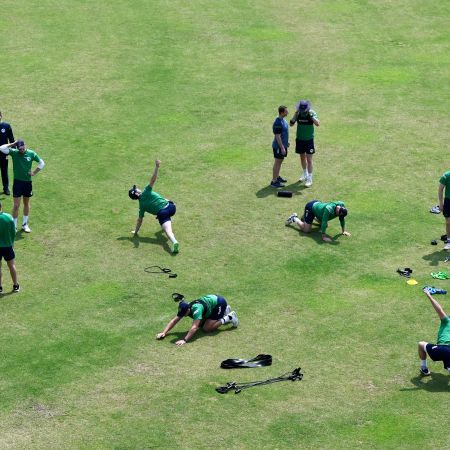Your hips are the engine room of the body — every day, they generate force and absorb impact, powering your body’s small tasks (like taking the first step out of bed) and big asks (completing a HIIT class).
When they’re tight, everything else has to compensate. It’s little wonder 80% of adults will experience low-back pain at some point in their lives — that’s a downstream consequence of stiff, underactive hips. So too is a shortened stride, compromised lifts, poor posture and the sobering knowledge that you may never hit top speed after your 30th birthday.
Where does this tightness come from? If you’ve read any of our wellness coverage before, you already have a good idea. Think: long days at the desk and workout sessions that neglect proper form or recovery — or worse, routines that regularly include both.
This guide will help you loosen up your hips for good. We spoke to experts who explained that it only takes a little bit of focused effort to relieve pain, boost performance and protect your mobility well into old age. Let’s get into it.
What Are Tight Hips?
The phrase “tight hips” gets bandied about a lot in gyms and on sports fields, but what exactly does it mean beyond some vague reference to pain in your hips and possibly lower back? What exactly is this tightness, and what can we do about it?
“When we talk about tight hips, we’re usually referring to muscles that have shortened or stiffened over time,” explains personal trainer and nutritionist Penny Weston. “Often, the specific muscles we’re talking about are the hip flexors, glutes and deep muscles like the piriformis.”
Because the hips play such a central role in how we move, tightness here can ripple through the body. “If my glutes are overcompensating, I can feel it in my calves, even into my lower back,” says Weston. That knock-on effect can leave you with numbness, discomfort or instability. “It’s not just localized pain,” she warns, “it’s your body trying to adapt and hold itself together.”
It’s Never Too Late to Start Pilates. Here’s How.
It looks gentle, but it torches the muscles that matter. No wonder Pilates is recruiting (and humbling) men everywhere. Here’s why it works — and how to stick with it.What Causes Tight Hips?
As multiple studies show, prolonged sitting and physical inactivity can lead to reduced mobility, on account of muscle stiffness. Weston says she’s experienced it herself after long sedentary periods.
It’s also possible you’ve been overdoing it with your running, without warming up first, which puts undue strain on your hips. You can also develop tightness from lunges or squats, especially if your form isn’t quite right or if you push through discomfort.
In all cases, working on your hips in the gym can help. Weston points to data in the Journal of Orthopaedic & Sports Physical Therapy, which found that strengthening the gluteus is essential for hip stability. “Weak abductors, which are responsible for stabilizing the pelvis, can be a big part of the problem,” she says. “If these aren’t strong enough, other muscles try to step in and end up overworked.”
In rare cases, you may be fighting an uphill battle. Ollie Weguelin, director of Sustain Performance, says that some of us are just genetically predisposed to different hip structures. “Some individuals can squat deeply with ease, while others feel restricted,” he says.
This isn’t always due to muscle tightness; it could be structural. “A shallow hip socket allows for greater hip flexion (e.g., in deep squats),” he adds, “while a deeper socket may cause a person to feel ‘blocked’ at end ranges.”
If you think your limitations may be more on the structural side, it’s worth sitting down with your healthcare professional before pushing yourself too hard at the squat rack.
How Do Tight Hips Affect Us Long-Term?
Beyond limiting your athletic performance — and perhaps making you irritable to be around, due to constant discomfort — tight hips can have larger implications for your health and well-being.
According to Weguelin, limitations in hip mobility can contribute to musculoskeletal dysfunctions. “The hips are foundational to movement,” he says. “Inactivity caused by hip dysfunction can contribute to chronic pain, reduced activity and lower quality of life as people age.”
“Tight hips don’t just limit how you move, they affect how you feel,” adds Weston. “They can throw off your posture, impact your balance and even affect your breathing if your pelvis is misaligned. There’s also evidence linking reduced hip mobility in later life to a higher risk of falls, pain conditions and loss of independence, so keeping the hips mobile isn’t just about comfort now, it’s an investment in long-term health.”
First, Are There Any Products That Can Help?
“Consistent mobility work is what really makes a lasting difference in keeping the body moving well,” says Weston. But if you’re in need of a more immediate fix, you might want to try the following:
- Massage balls: “These can be very effective, particularly for targeting the glutes and the sides of the hips,” says Weston. “Lying on one and gently rolling over the tight area can help release tension, and while it may feel uncomfortable at first, it tends to be highly effective.”
- Massage guns: “Foam rollers and massage guns, while not directly changing the length or tension of muscles, can help people move with more freedom, which in turn will enable them to challenge their body and drive adaptation through a proper training stimulus,” says Weguelin.
- Anti-inflammatories: “Advil, Motrin or a warming gel may be used, though they aren’t long-term solutions,” says Weston.
The Charge by InsideHook
A wellness newsletter to help you move better, think clearer and stay in the game longer. One email every Monday — we’re building habits, not chasing hacks.
What Should I Do About it?
When addressing tight hips, Weguelin says it’s important to focus on three areas: strength, mobility and stability. Like a house of cards, remove one component and your hip health will teeter.
“Listen to your body when working out,” he advises. “If you feel pain (as opposed to stretch or discomfort), it’s a sign to reassess form, load or technique because stretching into pain can sometimes aggravate rather than help tight hips.”
Add the routine outlined below to the end of your workouts over the course of a week. You should feel looser — and happier — in no time.
Mobility
Elevated Pigeon Stretch: Get hold of a bench. Place your front leg horizontal in front of you on the bench, with your other leg extended behind you for stability. Rock forward over your front leg, feeling the pull through your hip. About 20 seconds per side should do it.
Hip 90/90s: Sit with one leg in front, one leg behind you, both knees bent at 90 degrees. If you can’t quite get your knees touching the ground, throw a block under there. Again, hold for 20 seconds before swapping your legs around, if you can.
Couch Stretch: With your back and butt against a wall, you’re going to pull one leg up behind you, like you’re stretching your hammies before a run. Keep the other leg in front of you at 90 degrees for support then swap.
Stability
Side Plank Abductions: Get into a side plank position, then lift your top leg up, and slowly back down, keeping it as straight as you can. As with everything here, aim for 20 seconds per side. This one may take some work.
Copenhagen Planks: Another tough one. Get into a plank position with your top leg resting on a bench. You’re going to lower your middle to the ground, maintaining a vertical line through the pelvis. Push down through your core and grounded arm to bring your bottom leg up to form a straight line — the bench should be sandwiched between your two legs.
Hip Airplane: Hinge at the hips. With your arms wide for balance, lift one leg off the floor behind you, aiming to bring it in line with your spine and head. Rotate your pelvis outward and then back in.
Strength
Lateral Lunge: Squat down, extending one leg fully out to your side as you do. Power back up, then swap legs.
Single Leg Lateral Box Step Down: Get a box, step up, step down on one foot, keeping your free leg straight and suspended by the side of the box as you do.
Romanian Deadlift (RDL): With your feet hip-width apart, grab a barbell and hinge at your hips, keeping your back straight to power the weight up. Squeeze your glutes at the top of the move, then slowly hinge at the hips to lower the weight again.
Front Foot Elevated Split Squat: Literally a forward squat, but with your front foot elevated on a brick or weight plate for added instability. Grab some dumbbells and have at it.
Whether you’re looking to get into shape, or just get out of a funk, The Charge has got you covered. Sign up for our new wellness newsletter today.



























